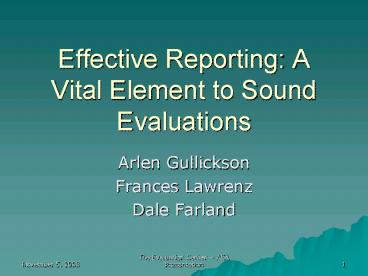Effective Reporting: A Vital Element to Sound Evaluations PowerPoint PPT Presentation
1 / 22
Title: Effective Reporting: A Vital Element to Sound Evaluations
1
Effective Reporting A Vital Element to Sound
Evaluations
- Arlen Gullickson
- Frances Lawrenz
- Dale Farland
2
At Issue
- Preparing and presenting evaluation findings in
ways that will be received, heard, and used
effectively is often a daunting task. - Sound reporting includes substantial elements of
follow up, negotiation, and persuasion - Plato may have said these things. If so, his
report was misplaced.
3
Presentation Organization
- Evaluation context
- The program evaluation standards as an organizer
- Example Reporting Strands
- Report Exemplars
4
Context General
- Client National Science Foundation (NSF)
Research, Evaluation and Communication (REC)
Division - Evaluation Object Advanced Technological
Education Program (ATE) - Grant rather than contract
- Large scale (2.5M)
- Long term (6 years)
- Commenced in 1999
5
Object Advanced Technological Education (ATE)
program
- Promotes improvement in technological education
- Undergraduate and secondary school levels
- Supports curriculum development the preparation
and professional development of college faculty
and secondary school teachers internships and
field experiences for faculty, teachers, and
students and other activities - Emphasis on two-year colleges, the program
focuses on the education of technicians for the
high-technology fields that drive our nation's
economy
6
The Program Evaluation Standards
- A Focus on Utility
- U1 Stakeholder Identification
- U3 Information Scope and Selection
- U5 Report Clarity
- U6 Report Timeliness and Dissemination
- U7 Evaluation Impact
7
U1 Stakeholder Identification
8
U3 Information Scope and Selection
- Project data and report elements are determined
via interaction with NSF staff and ATE project
principal investigators. - Annual Web-based survey -- Broad, overarching
issues - Site Visits, observations, interviews, special
surveysTargeted studies
9
U5 Report Clarity
- Fit report media to stakeholders
- Use multiple methods
- Partition reports to serve identified needs
- Key reports to specific audiences
- Employ stakeholder reviews
10
U6 Timeliness and Dissemination
- Multiple report methods (e.g., 6 for one survey)
- Pre plan/organize (e.g., on-line item report)
- Vary report type by audience (e.g., tri-fold
brochure) - Use interesting physical objects to lure
stakeholders to your reports (e.g., bookmarks)
11
U7 Increasing Impact
- Delimit information presented
- Ensure relevance of information to stakeholders
- Choose information packaging carefully
- Deliver in multiple ways
- Engage the recipient in personal ways
12
Exemplar Reporting Strands
- Annual Survey
- Targeted Investigation Sustainability
13
Annual Survey Report Tools (in order created)
- On-line item summary
- Fact Sheet
- Full report
- Executive summary
- On-line data viewer (OLAP)
- PowerPoint
14
Special Topics
- Issue Papers (9)
- Executive Summaries
- Issues at a Glance
- Monograph
- Journal Publication
Metaevaluation Report
15
Special Topic--Sustainability
- Tri-fold brochure
- PowerPoint Presentation
- PI Conference presentation
- Video Conference
- Electronic Synthesis
16
Stakeholder-AccountabilityPurposes
17
Stakeholder-Development Purposes
18
On-Line Item Summary
- Web-based
- Immediate upon close of survey
- Restricted to NSF staff and PIs
- Information tailored to PI
- Data not vetted
- GPRA and Project Planning
19
On-Line Item SummaryScreen Capture
20
On-Line Data ViewerOLAP
- Web-based
- Publicly available
- Data Manipulation tools prepackaged
- Research Orientation
- Data fully vetted
21
On-Line Screen Capture
22
Electronic Synthesis
- Used Full Report as Framework
- Use a video conf. reporting context to enhance
the full report. - Incorporates others (presenters)
- Provides audio and video via hyperlinks
- Adds interest, personal emphases, nuances
- Hopefully, here is how it works
23
The End
- Visit our Web site at
- http//www.wmich.edu/evalctr/ate/
24
Fact Sheet
- Approximately 2-weeks following close of survey
- One to 3 pages Survey Highlights
- Restricted to NSF program officers
- Data minimally vetted
- GPRA and Program Planning
25
Full Report
- 2 to 3 months following survey close
- Preparation includes substantial interaction with
NSF staff - Extensive Report (e.g., 50 pages of text and
tables) Well documented - NSF staff, project staff, and interested others
- Program Development and Accountability, Project
development
26
Executive Summary
- In tandem with full report
- Most carefully vetted of all reports
- NSF ATE staff, project staff, interested others,
and NSF REC staff - Brief -- addressing key indicators, conclusions
and recommendations - Accountability, program development
27
Test
28
Tom Bailey Definition of Sustainability

